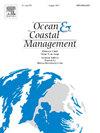Assessing ecological efficiency, spatial spillovers, and configurational drivers of recreational fisheries in the United States
IF 4.8
2区 环境科学与生态学
Q1 OCEANOGRAPHY
引用次数: 0
Abstract
This study employs an interdisciplinary integrative approach to systematically assess the spatiotemporal evolution, spatial spillover effects, and driving mechanisms of recreational fisheries ecological efficiency (RFEE) across U.S. coastal states. First, the non-radial Super-SBM model is utilized to measure RFEE levels, incorporating carbon emissions as an undesirable output, thereby enhancing the environmental adaptability of the evaluation. Second, social network analysis (SNA) is employed to reveal the structural relationships and centrality distribution of RFEE within interstate spatial networks. Further, the Spatial Durbin Model (SDM) is applied to identify the direct effects and spatial spillover pathways of factors such as population density, technological research and development, industry scale, and economic development on RFEE. Lastly, fuzzy-set qualitative comparative analysis (fsQCA) is used to uncover the configurational paths of multiple interacting factors, identifying RFEE enhancement patterns such as “technological innovation and population agglomeration” and “locational advantages and resource optimization.” The findings highlight that technological advancement is the primary driver of ecological efficiency improvements, while increasing industrial concentration exerts a significant inhibitory effect on both local and neighboring areas' RFEE. Based on these insights, the paper proposes context-specific ecological management recommendations, emphasizing the adoption of a strategy combining “moderate scale expansion, decentralized layout, and cross-regional ecological compensation.” The research not only enriches the understanding of RFEE measurement and spatial diffusion mechanisms but also provides theoretical support and practical pathways for promoting the green, low-carbon transformation of tourism and sustainable fisheries governance.
评估美国休闲渔业的生态效率、空间溢出和配置驱动因素
本研究采用跨学科综合方法对美国沿海各州休闲渔业生态效率(RFEE)的时空演化、空间溢出效应和驱动机制进行了系统评估。首先,利用非径向的Super-SBM模型测量RFEE水平,将碳排放作为不良输出,从而增强了评价的环境适应性。其次,利用社会网络分析(SNA)揭示了州际空间网络中RFEE的结构关系和中心性分布。在此基础上,运用空间德宾模型(Spatial Durbin Model, SDM)分析了人口密度、技术研发、产业规模、经济发展等因素对区域使用费的直接影响及其空间溢出路径。最后,利用模糊集定性比较分析(fsQCA)揭示了多因素交互作用的配置路径,确定了“技术创新与人口集聚”、“区位优势与资源优化”等区域经济效益增强模式。研究结果表明,技术进步是生态效率提升的主要驱动力,而产业集中度的提高对区域和周边地区的生态效率都有显著的抑制作用。在此基础上,提出了“适度扩张、分散布局、跨区域生态补偿”相结合的生态治理策略。该研究不仅丰富了对RFEE测度和空间扩散机制的认识,而且为促进旅游绿色低碳转型和渔业可持续治理提供了理论支持和实践路径。
本文章由计算机程序翻译,如有差异,请以英文原文为准。
求助全文
约1分钟内获得全文
求助全文
来源期刊

Ocean & Coastal Management
环境科学-海洋学
CiteScore
8.50
自引率
15.20%
发文量
321
审稿时长
60 days
期刊介绍:
Ocean & Coastal Management is the leading international journal dedicated to the study of all aspects of ocean and coastal management from the global to local levels.
We publish rigorously peer-reviewed manuscripts from all disciplines, and inter-/trans-disciplinary and co-designed research, but all submissions must make clear the relevance to management and/or governance issues relevant to the sustainable development and conservation of oceans and coasts.
Comparative studies (from sub-national to trans-national cases, and other management / policy arenas) are encouraged, as are studies that critically assess current management practices and governance approaches. Submissions involving robust analysis, development of theory, and improvement of management practice are especially welcome.
 求助内容:
求助内容: 应助结果提醒方式:
应助结果提醒方式:


